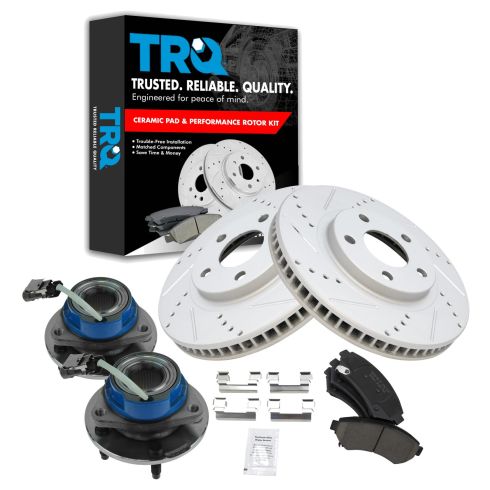1ABMS00058-Front Ceramic Performance Brake Pad & Rotor Kit with Wheel Bearings TRQ Performance BKA14851

Replaces
1997 Cadillac Deville with ABS Brakes with Rear Disc Brakes Front Ceramic Performance Brake Pad & Rotor Kit with Wheel Bearings TRQ Performance BKA14851

Product Reviews
Loading reviews
4.73/ 5.0
11
11 reviews
Happy customer
March 19, 2017
At first I thought it was too cheap to be true. The installation was easy and the video that email it was easy to understand. I will definitely look on his site the next time I need a part thank you for your help.
Great product, great service!
July 14, 2017
My 02 Bonneville SE had its ABS and traction control lights on, and I could feel it when braking, intermittently. Went to a big name chain, who quoted me $250 for a single bearing/hub (part only). Keep in mind they couldn't tell which side it was and told me to keep driving until one wheel was worse and wobbly. Didn't want to do that. Found this set with TWO to replace BOTH sides as well as high performance rotors and pads, for LESS than the price of what the shop guys would have charged me for a single bearing. There was a mix-up in the listing but they sorted it out and next-day aired the part to me at no cost. Great customer service by people who speak English. After the install, my lights are off the dash and the brakes work great. First time with this brand so, we will see how they hold up!
Nice stuff right price
January 6, 2019
Everything fit was here on time right price good quality
Goodnparts
March 19, 2019
A1 delivered a good product
Quality products and service
October 15, 2019
The parts were shipped in a timely manner and when I received them they were as ordered and in great shape. Securely packaged parts and will definitely order from 1A again!
Very good quality parts
January 11, 2021
I'm very satisfied with the parts I got they are good quality
1A AUTO IS CHANGING THE GAME
April 21, 2021
I've searched high and low for good quality oem upgrade replacement parts...
OOoowwee...they compliment the car so well, then the function of the parts is definitely a bigger upgrade then I anticipated..i mean of course going from reg. to crossed drilled is a change in itself.. but I've have the more socially popular brands before ...and this TRQ is way too much quality for the money..
Not embellishing one bit...
I recieved other parts from them and its the same results...I never paid attention to when they started out, maybe I was slow...but if you know what you want, I'd check here first to get it.
June 30, 2022
Great product quick service
Excellent
April 28, 2023
Perfect fit and the customer service was excellent as always, main reason I keep coming back, their customer service
Happy with the purchase.
January 7, 2024
Good fit, easy installation. Good quality so far, installed for 30 days.
2002 bonneville front brakes
August 13, 2024
The set looks great but after about 2000 miles they brakes developed an annoying squeak.
Customer Q&A
No questions have been asked about this item.
Cadillac is a registered trademark of General Motors Company. 1A Auto is not affiliated with or sponsored by Cadillac or General Motors Company.
See all trademarks.


























